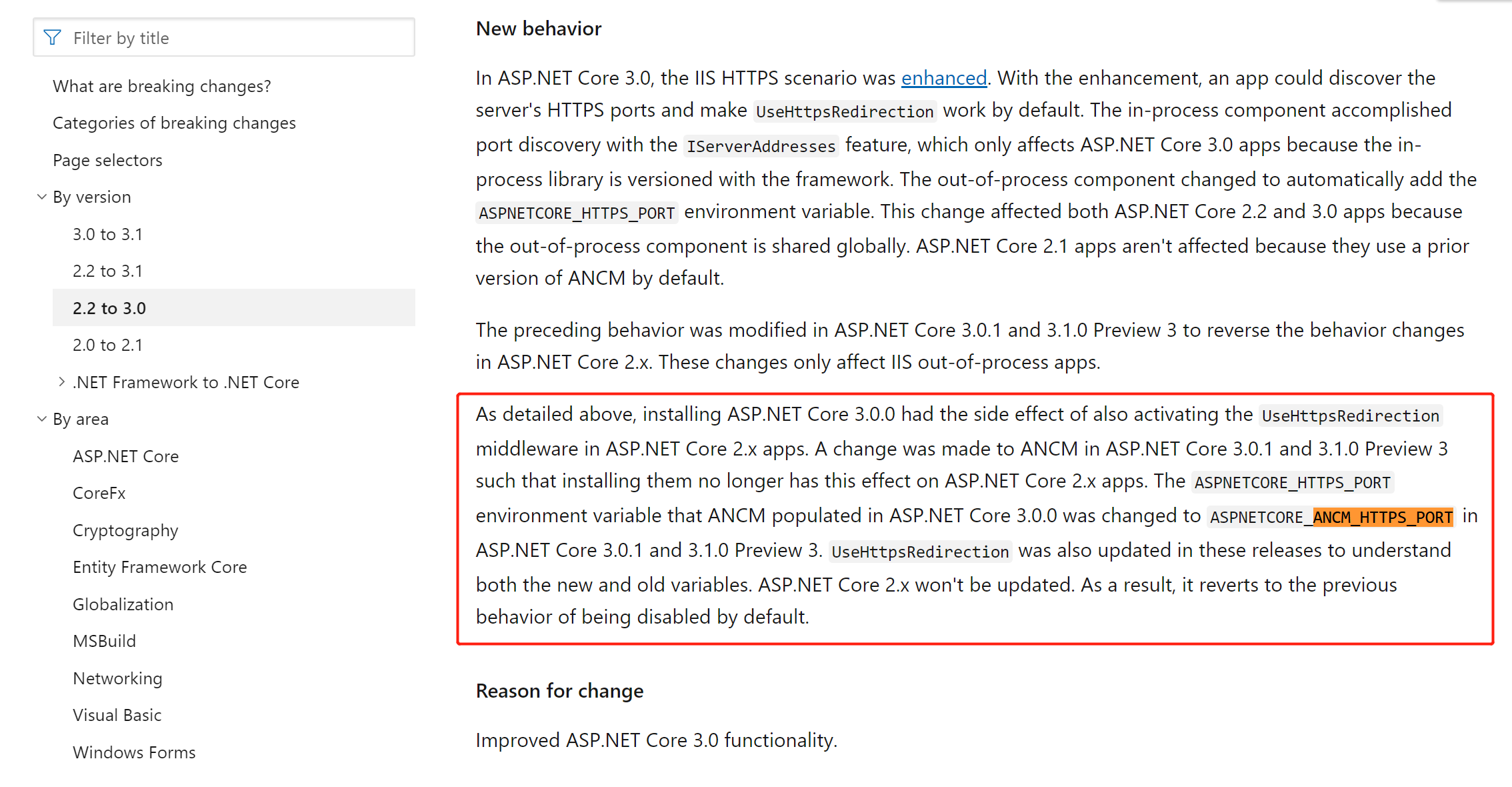AspNetCore3.1_Middleware源码解析_3_HttpsRedirection
概述
上文提到3.1版本默认没有使用Hsts,但是使用了这个中间件。看名字就很好理解,https跳转,顾名思义,就是跳转到
https地址。
使用场景,当用户使用http访问网站时,自动跳转到https地址。这样更加安全,不需要用户特意输入https://协议。
具体做了些我们一起来看看。
app.UseHttpsRedirection();
使用方法
跟Hsts一样,HttpsRedirection默认是不需要注入的,除非你需要修改默认配置。
services.AddHttpsRedirection(config =>
{
//https地址的端口号,默认null
config.HttpsPort = 12345;
//跳转响应的状态码,默认307
config.RedirectStatusCode = 302;
});
直接使用中间件即可
app.UseHttpsRedirection();
源码解析
源代码很简单,只有两个类:HttpsRedirectionOptions配置类,HttpsRedirectionMiddleware中间件
HttpsRedirectionOptions就只有两个配置项
/// <summary>
/// Options for the HttpsRedirection middleware
/// </summary>
public class HttpsRedirectionOptions
{
/// <summary>
/// The status code used for the redirect response. The default is 307.
/// </summary>
public int RedirectStatusCode { get; set; } = StatusCodes.Status307TemporaryRedirect;
/// <summary>
/// The HTTPS port to be added to the redirected URL.
/// </summary>
/// <remarks>
/// If the HttpsPort is not set, we will try to get the HttpsPort from the following:
/// 1. HTTPS_PORT environment variable
/// 2. IServerAddressesFeature
/// If that fails then the middleware will log a warning and turn off.
/// </remarks>
public int? HttpsPort { get; set; }
}
重点看下中间件做了些什么。代码量很少,大体是这些逻辑。
- 如果请求是Https,跳过本中间件
- 中间件会依次尝试从这三个地方取端口号:HttpsRedirectionOptions的配置,HttpsRedirectionOptions,HTTPS_PORT环境变量或配置,IServerAddressesFeature(如果Webhost上绑定了https地址,本中间件能够解析出来端口号)。
- 如果没有解析出来https的端口号,则跳过本中间件。
- 如果能够解析出来https端口号,则拼接出来https地址,返回307跳转响应报文(或者配置的其他状态码)。
注:3.1同时支持HTTPS_PORT和ANCM_HTTPS_PORT这两个环境变量。

https://docs.microsoft.com/en-us/dotnet/core/compatibility/2.2-3.0
public class HttpsRedirectionMiddleware
{
private const int PortNotFound = -1;
private readonly RequestDelegate _next;
private readonly Lazy<int> _httpsPort;
private readonly int _statusCode;
private readonly IServerAddressesFeature _serverAddressesFeature;
private readonly IConfiguration _config;
private readonly ILogger _logger;
/// <summary>
/// Initializes the HttpsRedirectionMiddleware
/// </summary>
/// <param name="next"></param>
/// <param name="options"></param>
/// <param name="config"></param>
/// <param name="loggerFactory"></param>
public HttpsRedirectionMiddleware(RequestDelegate next, IOptions<HttpsRedirectionOptions> options, IConfiguration config, ILoggerFactory loggerFactory)
{
_next = next ?? throw new ArgumentNullException(nameof(next));
_config = config ?? throw new ArgumentNullException(nameof(config));
if (options == null)
{
throw new ArgumentNullException(nameof(options));
}
var httpsRedirectionOptions = options.Value;
if (httpsRedirectionOptions.HttpsPort.HasValue)
{
_httpsPort = new Lazy<int>(() => httpsRedirectionOptions.HttpsPort.Value);
}
else
{
_httpsPort = new Lazy<int>(TryGetHttpsPort);
}
_statusCode = httpsRedirectionOptions.RedirectStatusCode;
_logger = loggerFactory.CreateLogger<HttpsRedirectionMiddleware>();
}
/// <summary>
/// Initializes the HttpsRedirectionMiddleware
/// </summary>
/// <param name="next"></param>
/// <param name="options"></param>
/// <param name="config"></param>
/// <param name="loggerFactory"></param>
/// <param name="serverAddressesFeature">The</param>
public HttpsRedirectionMiddleware(RequestDelegate next, IOptions<HttpsRedirectionOptions> options, IConfiguration config, ILoggerFactory loggerFactory,
IServerAddressesFeature serverAddressesFeature)
: this(next, options, config, loggerFactory)
{
_serverAddressesFeature = serverAddressesFeature ?? throw new ArgumentNullException(nameof(serverAddressesFeature));
}
/// <summary>
/// Invokes the HttpsRedirectionMiddleware
/// </summary>
/// <param name="context"></param>
/// <returns></returns>
public Task Invoke(HttpContext context)
{
if (context.Request.IsHttps)
{
return _next(context);
}
var port = _httpsPort.Value;
if (port == PortNotFound)
{
return _next(context);
}
var host = context.Request.Host;
if (port != 443)
{
host = new HostString(host.Host, port);
}
else
{
host = new HostString(host.Host);
}
var request = context.Request;
var redirectUrl = UriHelper.BuildAbsolute(
"https",
host,
request.PathBase,
request.Path,
request.QueryString);
context.Response.StatusCode = _statusCode;
context.Response.Headers[HeaderNames.Location] = redirectUrl;
_logger.RedirectingToHttps(redirectUrl);
return Task.CompletedTask;
}
// Returns PortNotFound (-1) if we were unable to determine the port.
private int TryGetHttpsPort()
{
// The IServerAddressesFeature will not be ready until the middleware is Invoked,
// Order for finding the HTTPS port:
// 1. Set in the HttpsRedirectionOptions
// 2. HTTPS_PORT environment variable
// 3. IServerAddressesFeature
// 4. Fail if not sets
var nullablePort = _config.GetValue<int?>("HTTPS_PORT") ?? _config.GetValue<int?>("ANCM_HTTPS_PORT");
if (nullablePort.HasValue)
{
var port = nullablePort.Value;
_logger.PortLoadedFromConfig(port);
return port;
}
if (_serverAddressesFeature == null)
{
_logger.FailedToDeterminePort();
return PortNotFound;
}
foreach (var address in _serverAddressesFeature.Addresses)
{
var bindingAddress = BindingAddress.Parse(address);
if (bindingAddress.Scheme.Equals("https", StringComparison.OrdinalIgnoreCase))
{
// If we find multiple different https ports specified, throw
if (nullablePort.HasValue && nullablePort != bindingAddress.Port)
{
_logger.FailedMultiplePorts();
return PortNotFound;
}
else
{
nullablePort = bindingAddress.Port;
}
}
}
if (nullablePort.HasValue)
{
var port = nullablePort.Value;
_logger.PortFromServer(port);
return port;
}
_logger.FailedToDeterminePort();
return PortNotFound;
}
}
OK,完成了。
AspNetCore3.1_Middleware源码解析_3_HttpsRedirection的更多相关文章
- AspNetCore3.1_Secutiry源码解析_4_Authentication_JwtBear
title: "AspNetCore3.1_Secutiry源码解析_4_Authentication_JwtBear" date: 2020-03-22T16:29:29+08: ...
- AspNetCore3.1_Secutiry源码解析_1_目录
文章目录 AspNetCore3.1_Secutiry源码解析_1_目录 AspNetCore3.1_Secutiry源码解析_2_Authentication_核心项目 AspNetCore3.1_ ...
- AspNetCore3.1_Secutiry源码解析_2_Authentication_核心对象
系列文章目录 AspNetCore3.1_Secutiry源码解析_1_目录 AspNetCore3.1_Secutiry源码解析_2_Authentication_核心项目 AspNetCore3. ...
- AspNetCore3.1_Secutiry源码解析_3_Authentication_Cookies
系列文章目录 AspNetCore3.1_Secutiry源码解析_1_目录 AspNetCore3.1_Secutiry源码解析_2_Authentication_核心流程 AspNetCore3. ...
- AspNetCore3.1_Secutiry源码解析_5_Authentication_OAuth
title: "AspNetCore3.1_Secutiry源码解析_5_Authentication_OAuth" date: 2020-03-24T23:27:45+08:00 ...
- AspNetCore3.1_Secutiry源码解析_6_Authentication_OpenIdConnect
title: "AspNetCore3.1_Secutiry源码解析_6_Authentication_OpenIdConnect" date: 2020-03-25T21:33: ...
- AspNetCore3.1_Secutiry源码解析_8_Authorization_授权框架
目录 AspNetCore3.1_Secutiry源码解析_1_目录 AspNetCore3.1_Secutiry源码解析_2_Authentication_核心流程 AspNetCore3.1_Se ...
- AspNetCore3.1源码解析_2_Hsts中间件
title: "AspNetCore3.1源码解析_2_Hsts中间件" date: 2020-03-16T12:40:46+08:00 draft: false --- 概述 在 ...
- 【原】Android热更新开源项目Tinker源码解析系列之三:so热更新
本系列将从以下三个方面对Tinker进行源码解析: Android热更新开源项目Tinker源码解析系列之一:Dex热更新 Android热更新开源项目Tinker源码解析系列之二:资源文件热更新 A ...
随机推荐
- deeplearning.ai 卷积神经网络 Week 3 目标检测
本周的主题是对象检测(object detection):不但需要检测出物体(image classification),还要能定位出在图片的具体位置(classification with loca ...
- 第十六届“二十一世纪的计算”学术研讨会 密西根州立大学教授Anil K. Jain主题演讲
Biometrics---How Do I Know Who You Are? 密西根州立大学教授Anil K. Jain主题演讲" title="第十六届"二十一世纪的 ...
- python列表推导式(扫盲)
1) 简单了解: 所谓的列表推导式,就是指的轻量级循环创建列表. 格式: 列表推导式的常见形式: my_list = [ item for item in iterable] my_list: 列表名 ...
- 使用java列举所有给定数组中和为定值的组合
import java.util.Arrays; public class SolveProb { ]; ;// 记录当前 public SolveProb() { } public static v ...
- 【XP系统下载U盘装系统】用电脑店超级U盘装XP系统详细图文教程
现在U盘装系统已经越来越流行了,不仅方便而且简单,由于U盘启动盘用的制作工具不同,其中比较流行的有老毛桃.电脑店.大白菜.一键U盘装系统等等,因此安装过程中也有不尽相同的,今天就和大家分享下利用电脑店 ...
- 从0开始学正则表达式-基于python
关于正则表达式,当我们了解它就不难,不了解就很难,其实任何事情都是这样,没有人一生下来就啥都会,说白了,每个人都是一个学习了解进步的过程.学习和掌握正则表达式可能并不是太简单,因为它确实是有点像“外星 ...
- 编写高质量 Objective-C 代码
第一章 熟悉 Objective-C 第一条:了解 Objective-C 起源 Objective-C 是 C 语言动态性扩充.使用"消息结构"而非"函数调用" ...
- 【bzoj3441】乌鸦喝水
Source bzoj3441 Hint 请先思考后再展开 按被删除的顺序考虑每个点,然后按照题意模拟 Solution 请先思考后再展开 被删除的顺序一定是按照[能被操作的次数]为第一关键字,位置作 ...
- zookeeper 实战 - Pymjer 的博客
下载 $ wget http://apache.forsale.plus/zookeeper/zookeeper-3.4.9/zookeeper-3.4.9.tar.gz 配置conf/zoo.cfg ...
- 当鼠标hover的时候,使用tip将overflow:hidden隐藏的文字显示完全
<!DOCTYPE html> <html> <head> <meta charset="UTF-8"> <title> ...
